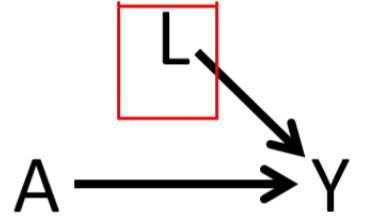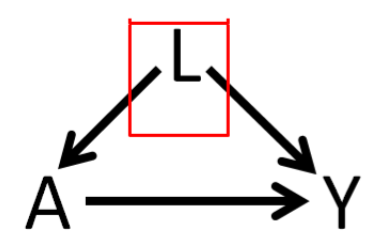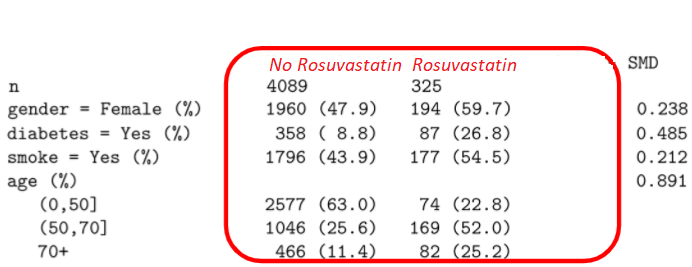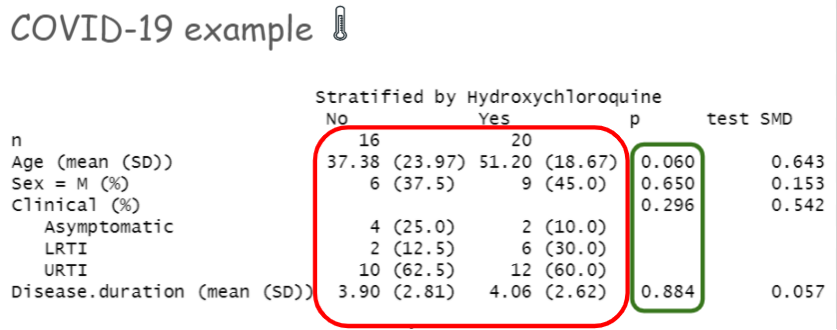Chapter 2 Balance and Overlap
2.1 Balance
Table 1 in any RCT paper is very important to assess the balance of the baseline characteristics between the two treatment arms.
Balance in RCT:
 |
 |
Compare the proportions in each age categories by eye-balling in making an evaluation.
In absence of randomization:
 |
 |
2.1.1 Measures of Balance
To compare baseline characteristics between the two treatment groups, we use
- t-test (for continuous variables) and
- chi-square test (for categorical variables)
Today we will introduce a new concept, known as standardized mean differences (SMD) that can be also used to compare baseline characteristics between the two treatment groups.
2.1.1.1 SMD
Austin (2011b)
- For continuous confounders:
- \(SDM_{continuous} = \frac{\bar{L}_{A=1} - \bar{L}_{A=0}}{\sqrt{\frac{(n_1 - 1) \cdot s^2_{A=1} + (n_0 - 1) \cdot s^2_{A=0}}{n_1 + n_0 - 2}}}\)
- \(\bar{L}_{A=1}\): mean of the continuous variable L for the treated group (A=1)
- \(\bar{L}_{A=0}\): mean of the continuous variable L for the untreated group (A=0)
- \(n_1\): number of treated individuals (A=1)
- \(n_0\): number of untreated individuals (A=0)
- \(s^2_{A=1}\): variance of the continuous variable L for the treated group (A=1)
- \(s^2_{A=0}\): variance of the continuous variable L for the untreated group (A=0)
- \(SDM_{continuous} = \frac{\bar{L}_{A=1} - \bar{L}_{A=0}}{\sqrt{\frac{(n_1 - 1) \cdot s^2_{A=1} + (n_0 - 1) \cdot s^2_{A=0}}{n_1 + n_0 - 2}}}\)
- For binary confounders:
- \(SDM_{binary} = \frac{\hat{p}_{A=1} - \hat{p}_{A=0}}{\sqrt{\frac{\hat{p}_{A=1} \times (1 - \hat{p}_{A=1}) + \hat{p}_{A=0} \times (1 - \hat{p}_{A=0})}{2}}}\) where \(\hat{p}{A=1}\) and \(\hat{p}{A=0}\) are the proportions of the two binary groups.
- For categorical confounders (more than 2 categories):
- Calculating SMD for categorical variables is slightly more complicated, requiring some additional calculation and averaging out the results from category-specific SMDs. See formulas in Yang and Dalton (2012). It is also possible to report SMD for each category separately (similar to binary).

Generally, \(0.1\) is used as a cut-point. But some suggest more liberal cut-points. More on that later.
COVID example from Gautret et al. (2020)
p-value vs. SMD

- Statistical tests are affected by sample size
- t-test
- McNemar tests
- Wilcoxon rank test
- Balance of what?
- statistical tests make inference about balance at the population level
- but we are really interested in balance at the sample level
2.2 Adjustment
2.2.1 Why adjust?
In absence of randomization, treatment effect estimate ATE = \(E[Y|A=1] - E[Y|A=0]\) includes
- Treatment effect
- Systematic differences in 2 groups (‘confounding’)
- Doctors may prescribe tx more to frail and older age patients.
- In here, \(L\) = age is a confounder.
In absence of randomization, if age is a known confounder, conditioning can solve the problem:
| Causal effect for young (\(<50\)) | \(E[Y|A=1, L =\) younger age\(]\) - \(E[Y|A=0, L =\) younger age\(]\) |
| Causal effect for old (\(\ge 50\)) | \(E[Y|A=1, L =\) older age\(]\) - \(E[Y|A=0, L =\) older age\(]\) |
Conditional exchangeability; only works if \(L\) is measured.
2.2.2 Adjustment Methods
Adjustment of imbalance could mean
- exact matching (Rubin 1973)
- stratification, restriction

|
When L includes a large number of covariates, matching method would result in a small sample size. |
Regression and machine learning methods are popular adjustment methods. Below is a list of adjustment methods that uses different combinations of exposure and outcome modelling.
| Method | Exposure model \((\color{green}{\text{A}} \sim ...)\) | Outcome Model \((Y \sim ...)\) |
|---|---|---|
| Regression (Gauss 1821 \(\dagger\)) | No \(\color{green}{\text{A}}\) modelling | Yes \((Y \sim \color{green}{\text{A}}+\color{red}{\text{L}})\) |
| Instrumental variable methods (2SLS) \(\dagger\dagger\) | \(A \sim IV + L\), but explicitly to obtain \(\hat{A}\) | \(Y \sim \hat{A} + L\) |
| Propensity score matching (Rosenbaum and Rubin 1983) | Yes \((\color{green}{\text{A}} \sim \color{red}{\text{L}})\) | Crude comparison on matched data \((Y \sim \color{green}{\text{A}})\) |
| Propensity score Weighting (Rosenbaum and Rubin 1983) | Yes \((\color{green}{\text{A}} \sim \color{red}{\text{L}})\) | Crude comparison on weighted data \((Y \sim \color{green}{\text{A}})\) |
| Propensity score double adjustment | Yes \((\color{green}{\text{A}} \sim \color{red}{\text{L}})\) | Yes \((Y \sim \color{green}{\text{A}}+ \color{red}{\text{L}})\) |
| Decision tree-based method (Breiman et al. 1984) | No \(\color{green}{\text{A}}\) modelling | Yes \((Y \sim \color{green}{\text{A}}+\color{red}{\text{L}})\) |
| G-Computation (J. Robins 1986) | No \(\color{green}{\text{A}}\) modelling | Yes \((Y \sim \color{green}{\text{A=1 vs. 0}}+\color{red}{\text{L}})\) |
| Random Forest (Ho 1995) | No \(\color{green}{\text{A}}\) modelling | Yes \((Y \sim \color{green}{\text{A}}+\color{red}{\text{L}})\) |
| Double robust (J. M. Robins and Rotnitzky 2001), (Van Der Laan and Rubin 2006) (augmented weighted, or TMLE), causal forest (Athey and Wager 2019), double machine learning (DML) (Chernozhukov et al. 2017), potentially using machine learning | Yes \((\color{green}{\text{A}} \sim \color{red}{\text{L}})\) | Yes \((Y \sim \color{green}{\text{A}}+ \color{red}{\text{L}})\) |
\(\dagger\) (Stanton 2001). \(\dagger\dagger\) other economic models also exists: Structural equation modeling, Difference-in-differences, Regression discontinuity, Interrupted time series
2.3 Lack of overlap
- “Lack of complete overlap” happens if there is a baseline covariate space where there are exposed patients, but no control or vice versa.
- Region of ‘no overlap’ is an inherent limitation of the data.

- Regression adjustment usually do not offer any solution to this.
- Consequently, inference is not generalizable beyond the region of overlap.